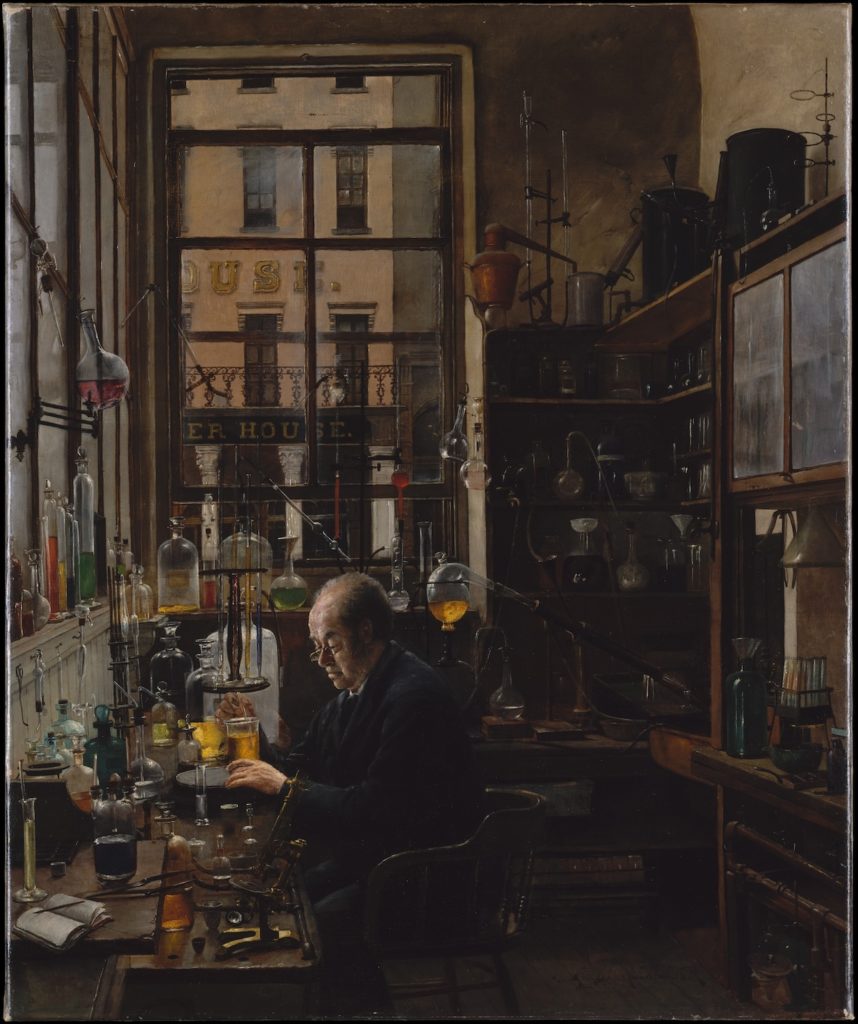
Thomas Price sitting in the San Francisco laboratory. A consultant to international mining companies, Price was noted for his practical and theoretical knowledge of metals and mines. Oil painting by Henry Alexander ca. 1885–87.
Thomas Price was one of the most educated assayers on the western frontier. Educated in an English school of mines, Price was exposed to western American ores while working in Swansea, Wales. The nature of the ores, and the continued reports of their greatness caused him to move to America, where he worked for two of the leading assay and refining houses in San Francisco for more than twenty years, before opening his own company. He was a leader in the educational community, attained great success, and passed along the firm to his children.
Born In Wales
Thomas Price was born in Brecon, Breconshire, Wales about 1835. He was educated at Normal College in Swansea, Wales, and the Royal School of Mines in London. In Swansea, he started or worked in an assay business, and became a professor there. Swansea was well known to the mining world, because most of the world’s copper ores were smelted at Swansea in 1860. There was so much work there, that most of the metallurgists worked in Swansea at one time or another around 1860.
With the discovery of silver-gold ores of the Comstock, mine owners sent samples to Swansea for analysis. Undoubtedly Price, as well as others, found the ores intriguing and challenging, and were off to California and Nevada and a whole new field of metallurgical work. He departed Wales in 1862 and traveled directly to San Francisco, where he made his home.
San Francisco Origins
Price went to work as an assayer with Kellogg, Hewston & Co. He began teaching a series of private assay and chemistry classes in San Francisco about 1862 or 1863, advertising in the Mining and Scientific Press, the news organ for the western scientific community. The classes lasted for three months, two nights a week, and by June 1863, he was attracting twenty or more students to each class.
By around 1865, he supplemented his assaying career by teaching chemistry at the San Francisco City College and Toland Medical College. Kellogg, Hewston & Co. was purchased and the name of the firm changed to the San Francisco Assaying & Refining Works, and Price continued there.
In 1875, Price left the firm and started his own assaying business. About ten years later, he brought in his son as a partner, and changed his firm’s name to Thomas Price & Son. His career was flourishing, and many of his students went on to become assayers, among them Henry Hanks, later a prominent San Francisco assayer himself.
About 1880 Price began using the initials M. D. after his name, probably because of a degree earned from Toland Medical College. By 1887 Price’s business at 524 Sacramento Street had grown. He employed thirteen assistants and boasted the latest and most complete equipment and services. During the course of his career he examined mining properties in all the major mining locations of the west, and even in North Carolina. In 1892 he was commissioned to supervise the establishment of an enormous mining plant in South Africa.
Price died at home at the age of 77 on October 13, 1912. He was father to Arthur, Minnie and Annie, and Mrs. J.P. Turner.
The Thomas Price Ingots
Thomas Price ingots are very rare. There are perhaps less than five silver and one gold ingot known. They date to the 1875-1885 period when Price was on his own before his son was added as a partner.
The Price logotype punch closely resembles the logo punch of the Kellogg & Humbert ingots of the S.S. Central America, with two lines of text held within a rectangle. This commonality is not by chance, since Price first worked for Kellogg & Hewston, the successors to Kellogg & Humbert, and both companies used logotype punches that were identical in style. The same held true for the next successor, the San Francisco Assaying & Refining Works. Since Price worked for two of these firms for years, it makes sense that he would adapt a similar style logotype for his own use.
Of additional interest is that the logotypes are made in a specific manner. In each case, the logotype is a classic bullion punch – the iron punch has the letters formed backwards, extruding from the body of the punch, such that when punched or hammered into the ingot, all lettering is depressed, or incuse. This is typical of nearly all the S.S. Central America ingots, and all of the Comstock ingots and ingot punches known today. The possible exception is the “seeing eye” of Harris & Marchand and later Harvey Harris.
3.90oz Silver & Gold assay ingot, 1881
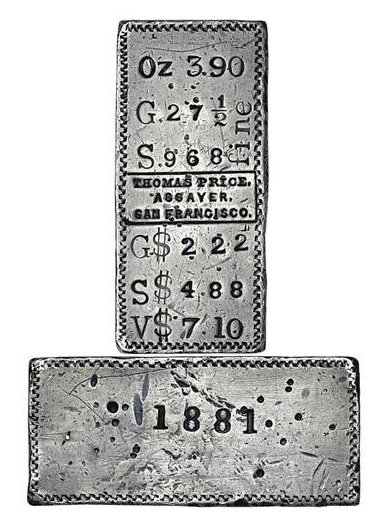
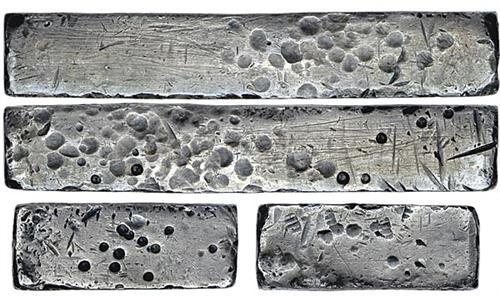
Overall appearance of Very Fine. A little scuffy and banged up looking with many small round depressions on all sides. Inscriptions and logotype on face fully legible, date bold as shown in the illustration. The assayer’s bullion punch is in logotype as is the word “fine”, here unusually all in lower case. “Oz” may also be in logotype but the cataloguer cannot be certain of this. All other numerals and letters accomplished by individual punches. Face and back ornamented around the edge. All edges squared off, corners sharp, faces smoothed but not polished. The bar looks like it may have been intended as a presentation piece and the prominent date on the back and lack of an ingot number support this. Manufactured before Professor Price associated his son Arthur in the business sometime just before or during 1889.
- Face: Oz 3.90 / G.27 1/2 / S.968 / fine [to the right and lengthwise beside the last two] / THOMAS PRICE.ASSAYER.SAN FRANCISCO [in logotype] / G$2.22 / S$4.88 / V$7.10.
- Back: 1881.
- Top side: blank.
- Bottom side: blank.
- Left side: blank.
- Right side: blank.
- Dimensions: 52.3 x 24.0 x 9.25 mm.
- Current weight: 120.4 gms.
From the John J. Ford, Jr. Collection
Provenance: Noted as in the Kagin Collection on June 24, 1958. Mr. Ford’s informational card and photographs accompany the lot.
[10/2007] https://auctions.stacksbowers.com/lots/view/3-AV6O9/thomas-price-assayer-san-francisco-california-silver-gold-assay-ingot-1881 ($27,600)
[03/2024] https://bidnow.vegascoindealer.com/Listing/Details/223455/Very-Rare-1881-Thomas-Price-Assayer-Silver-Gold-Possible-Presentation-Ingot ($43,477)
2.17 Oz Silver & gold assay ingot no. 1769.
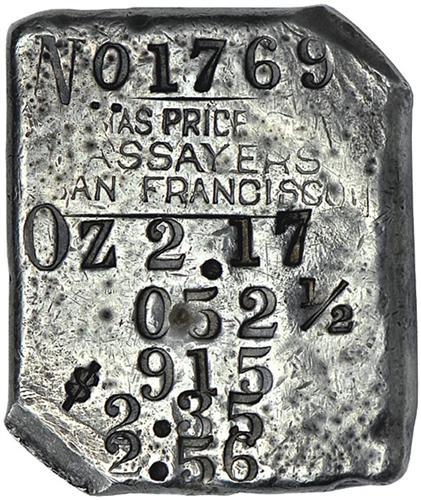
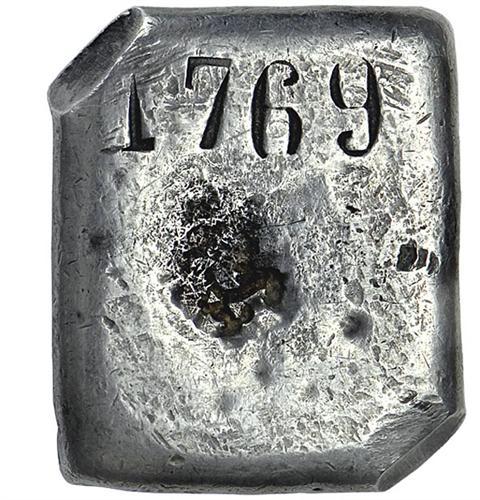
Overall appearance of Fine to Very Fine. This ingot has a classic charm about it of a functional assay piece. The piece is light silver gray in color. The ethnic is the same punch seen on the preceding lot, here incomplete. “Oz” and “No” appear to be in logotype but all other letters and numbers were accomplished by individual punches. Two opposing corners have been imperfectly cut from the bar. There are, surprisingly, no letter indications for either the gold or silver contents and the values have been left undefined on the bar, leaving one to guess at which is which by virtue of the ingot’s silver color. This seems sloppy and crude from an operation praised by contemporaries as the most elaborate west of Chicago. What the bar lacks in finesse it more than makes up for in size, shape, and feel. This ingot has a most satisfying “feel” in the hand.
- Face: No.1769 / THOMAS PRICE /// ASSAYERS SAN FRANCISCO. in logotype / Oz 2.17/052 1/2 / 915 / $2.35 / 2.56.
- Back: 1769.
- Top side: blank.
- Bottom side: blank.
- Left side: blank.
- Right side: blank.
- Dimensions: 36.0 x 30.4 x 6.9 mm.
- Current weight: 67.86 gms.
From the John J. Ford, Jr. Collection
Provenance: Ex Paul Franklin on September 4, 1964.
On this ingot his bullion punch is modeled after the well known Kellogg & Humbert bullion punches seen on the SSCA gold ingots, and in their successor company silver ingots known today, as well as those seen in early authentic period photographs. The ingot is .915 fine silver and .0525 fine gold, typical of the Comstock, but also typical of other silver regions as well. The source of the silver could be determined at a future date from metals fingerprinting once the silver database is enlarged to include the many western silver camps of the 1860’s and 1870’s. This ingot has the usual assay chips taken from opposing corners.
[10/2007] https://auctions.stacksbowers.com/lots/view/3-AV6OL/thomas-price-son-assayers-san-francisco-california-silver-gold-assay-ingot-no-1769 ($16,100)
[10/2010] https://www.icollector.com/San-Francisco-CA-c1860-1870-Thomas-Price-Silver-Ingot-No-1769_i9799291 ($19,200)
[12/2024] Private ($55,000)
2.04 oz Silver Assay Ingot
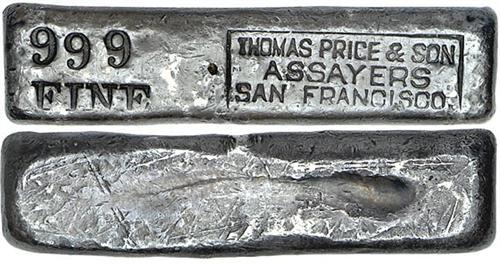
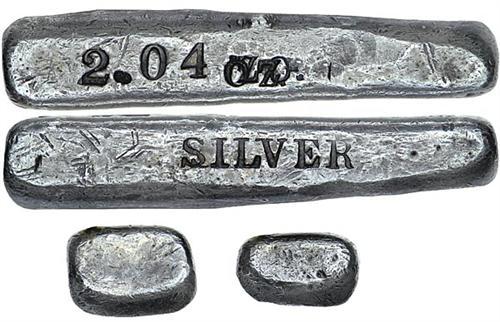
Overall appearance of Fine. A very rough and somewhat misshapen little ingot. Quite dark silver gray in color. This is a most unprepossessing bar but the complete ethnic (the assayer’s bullion punch) makes it quite important. This bar is not terribly well formed, being thinner on one side than the other, and it hasn’t been well finished. It has the look of a bar that was not meant to be around long, certainly not to be saved as a presentation piece.
- Face: 999 / FINE at the left, THOMAS PRICE & SON ASSAYERS SAN FRANCISCO. in logotype at the right.
- Back: blank.
- Top side: 2.04 OZ. [over ZO.].
- Bottom side: SILVER.
- Left side: blank.
- Right side: blank.
- Dimensions: 52.6 x 13.5 x 10.0 mm.
- Current weight: 63.52 gms.
From the John J. Ford, Jr. Collection
Provenance: Noted as in the Kagin Collection on May 28, 1966. Mr. Ford’s informational card and Rankow photographs accompany the lot.
[10/2007] https://auctions.stacksbowers.com/lots/view/3-AV6OF/thomas-price-son-assayers-san-francisco-california-silver-assay-ingot ($23,000)
[03/2018] https://auctions.stacksbowers.com/lots/view/3-9J482/california-san-francisco-thomas-price-son-assayers-silver-ingot-526-x135-x-100mm-6352-grams-fine ($8,400)
5.50oz Silver & Gold Assay Ingot number 8612

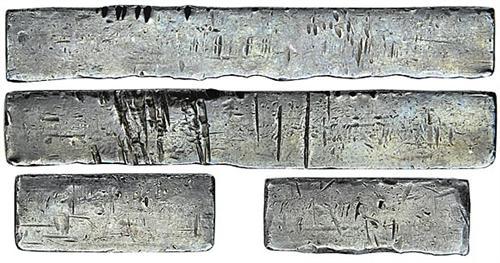
Overall appearance of Very Fine. A rather curious ingot in that it is unnamed. Its style, however, and the distinctive use of a lower case logotype for “fine” suggest Price as the assayer. Face and back outlined by an ornamental border. The piece is medium silver gray in color.
- Face: No.8612. / Oz. 5.50 / G.18 1/2 / S.947 / fine [to the right and lengthwise beside the last two] / [space for the assayer’s name, here omitted] / G.$2.10 / S.$6.73 / V.$8.83.
- Back: blank.
- Top side: blank.
- Bottom side: blank.
- Left side: blank.
- Right side: blank.
- Dimensions: 62.7 x 25.8 x 10.0 mm.
- Current weight: 168.7 gms.
From the John J. Ford, Jr. Collection
Provenance: Noted as in the Kagin Collection on August 30, 1956 and December, 1957. Mr. Ford’s informational card and photographs accompany the lot.
[10/2007] https://auctions.stacksbowers.com/lots/view/3-AV6OR/thomas-price-assayer-san-francisco-california-silver-gold-assay-ingot-number-8612 ($8,050)
2.91oz Silver & Gold Assay Ingot number 7471
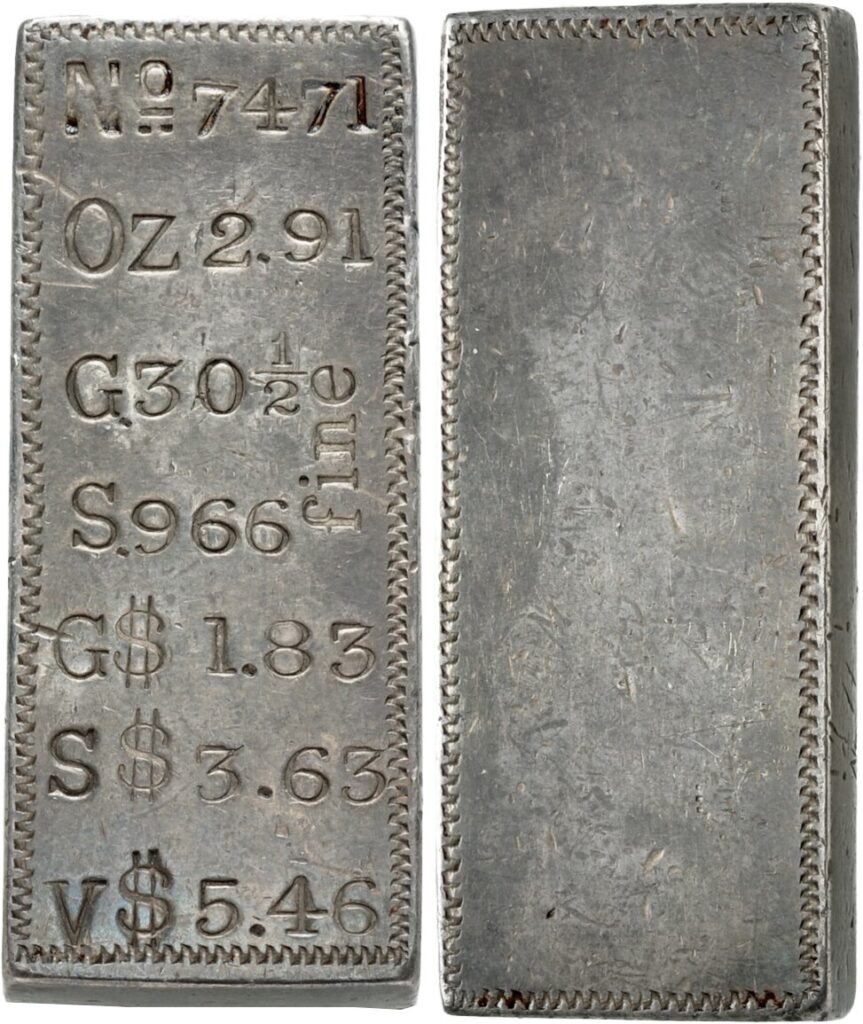
Thomas Price, Assayer. San Francisco, California. Silver & gold assay ingot number 7471. Undated (1875-1885). Although unnamed, the style and the distinctive use of a lower case logotype for “fine” suggest Price as the assayer. Face and back are outlined by a crenelated ornamental border. All stamps are on the front face: NO 7471/ OZ 2.91/ G.30½/ S.966 fine/ G $1.83/ S $3.63/ V $5.46 in seven lines; all within border. The ingot itself measures 22.5mm wide, 55.5mm tall, 6.5mm deep.
From the Alexander Christopher Collection.
[05/2025] https://auctions.cngcoins.com/lots/view/4-GH2MQ4/thomas-price-assayer-san-francisco-california-silver-gold-assay-ingot-number-7471 ($35,937)
2.78oz Gold Ingot – The Only One
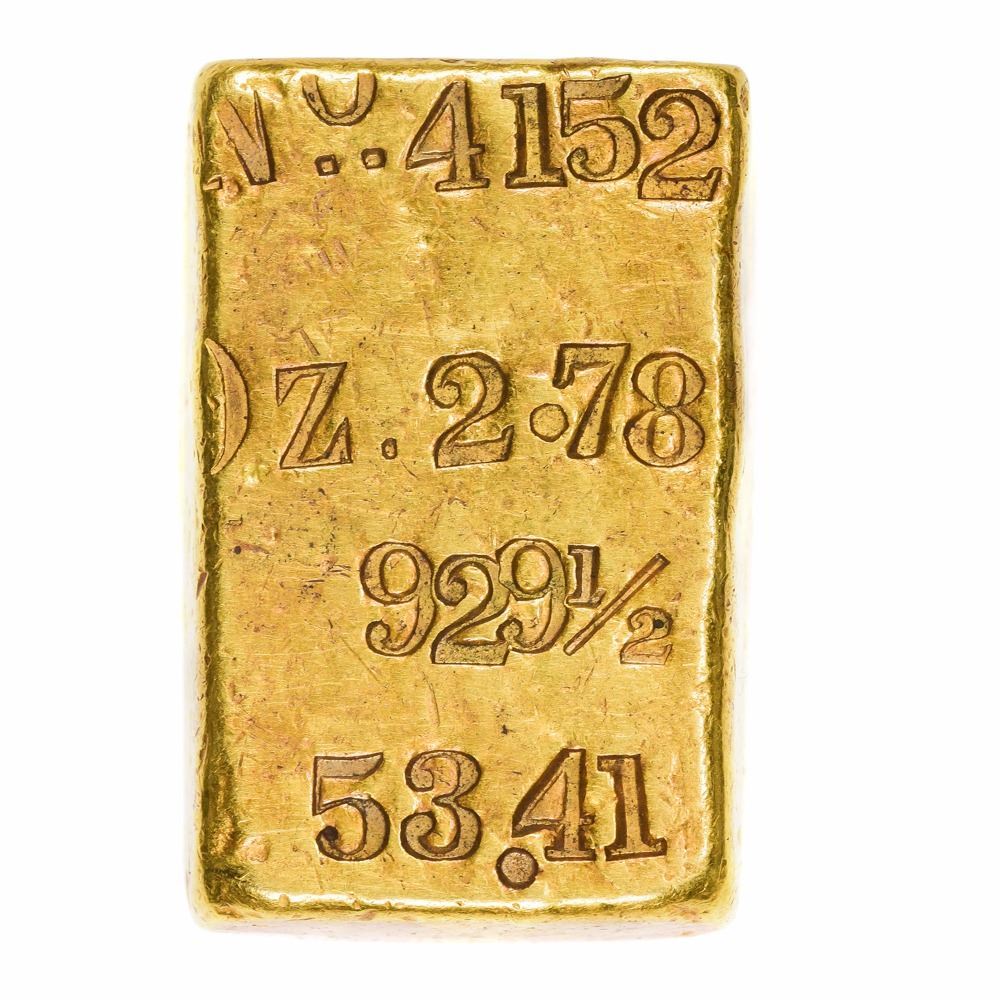
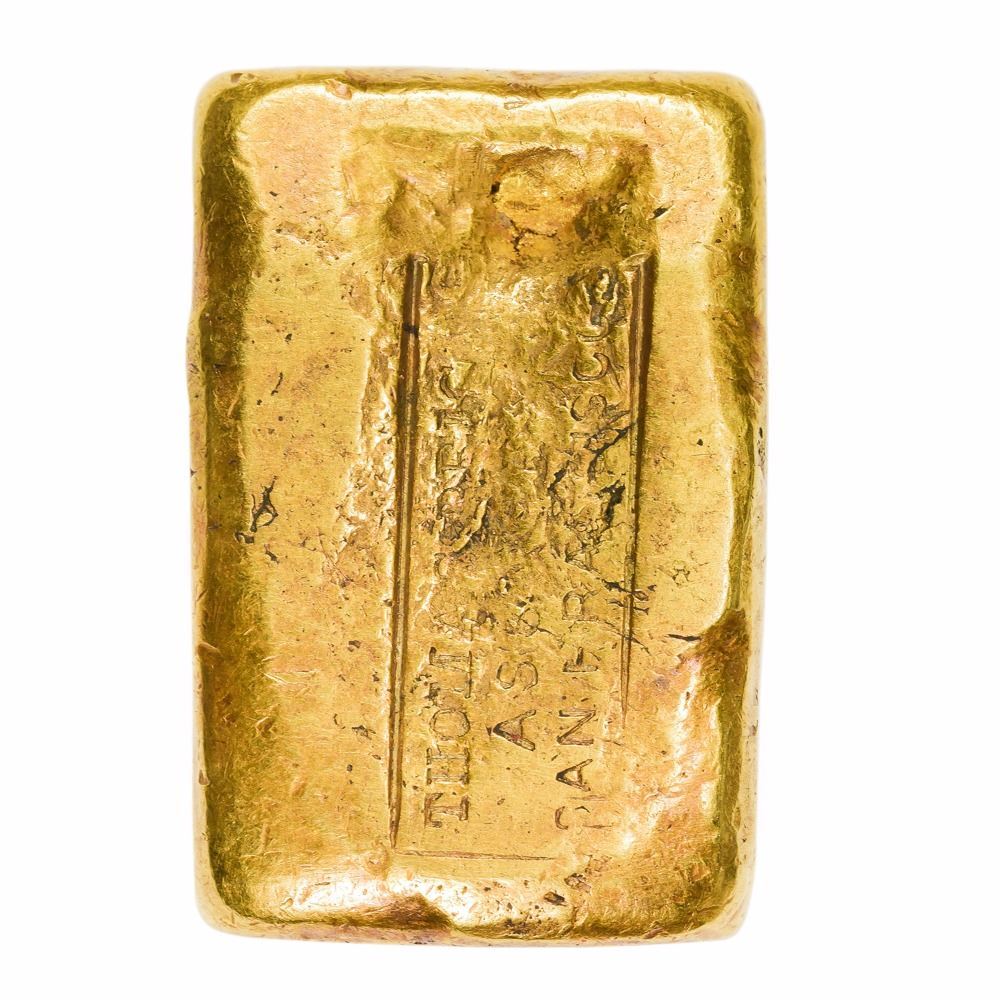
Deep yellow gold with an unusually high gold content, this ingot has a rich story to tell, see below. As they all are of the highest rarity, the appearance of any Price ingot, gold or silver, represents an important treasure for advanced ingot specialists.
The known Price ingots date to the 1875-1885 period when Price was on his own before his son was added as a partner.
This piece is absolutely exceptional as it is the ONLY surviving gold ingot known. Gold pieces from the 19th century are rare in their own right, and it is a special treat when you get to encounter a one-of-a-kind piece such as this one made by an important Assayer of the time.
Undoubtedly a functional ingot, this piece was likely used as actual currency given its present condition and wear. This piece stands atop all the other Thomas Price ingots as the only one made primarily out of gold at a stated purity level of 929.5 fine!
[08/2017] https://www.icollector.com/California-San-Francisco-Undated-Thomas-Price-Co-Assayers-Gold-Ingot-No-4152-2-78-ounces-9_i27907319 ($23,500)
7.57oz Low Silver and Gold Ingot – Oddball

Unlike most ingots that exist from Thomas Price, this is unique in that it appears to contain very low silver and gold purity. Stamped on the obverse is a scant .009 and .005 fine purity for silver and gold. One wonders what the other primary material is as it may contain high amounts of lead and/or copper.
[12/2012] https://www.icollector.com/Thomas-Price-Son-Assayers-Ingot-CA-San-Francisco_i14654240 ($14,937)
53.40 oz A Massive $78.69 Unparted Silver Bar Made by Thomas Price & Company
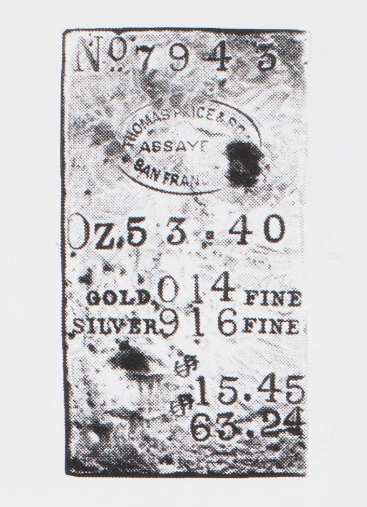
The bar is stamped with its serial number, 7943, the assaying firm’s name and location, its weight, 53.40 ounces, its gold and silver finenesses (.014 and .916, respectively), and the individual values of the gold and silver contents of the bar. (815.45 and $63.24, respectively).
[03/1990] https://archive.org/details/epnbox37-rf90-blakeargewllterr/page/n53/
[04/1980] https://nnp.wustl.edu/library/auctionlots?AucCoId=511370&AuctionId=521430
16.79 oz, $21.53 Silver Bar Made by Thomas Price Assayer San Francisco
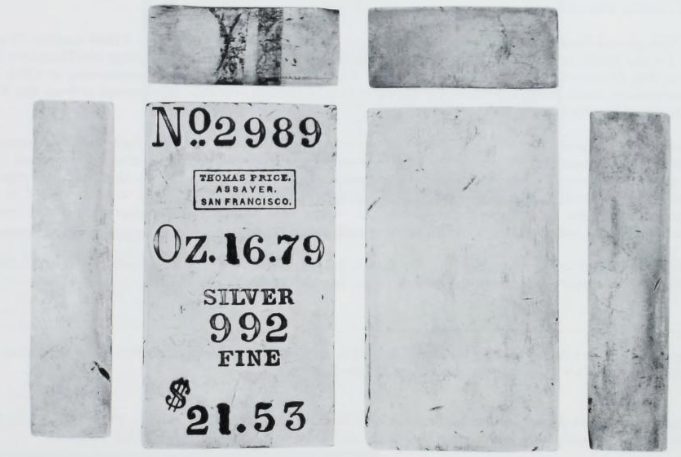
Undated [1870’s) silver ingot made by the San Francisco assaying firm operated by Thomas Price, located at 524 Sacramento Street. No. 2989. $21.53. 16.79 ozs.
992 Fine. 71.4 x 39.9 x 17.7mm. perfectly rectangular ingot. Essentially, as made and definitely for presentation purposes and not as an ordinary “run of the mill” ingot. The top and bottom faces and all four edges have been polished to a high shine. The eight straight edges are knife-like and all eight corners are sharp and uncut. On the top face is No..2989 above a small rectangular logotype punch engraved THOMAS PRICE ASSAYER SAN FRANCISCO above OZ. 16.79 SILVER 992 FINE $21.53, the numerals being individual punches, the other elements being logotypes. The bottom face and all four edges are blank. This is a newly discovered Thomas Price ingot, one of only three known (a much smaller gold ingot with a different Price logotype appeared in Bowers’ November, 1999 sale).
[01/2000] https://nnp.wustl.edu/library/auctionlots?AucCoId=3&AuctionId=516740
